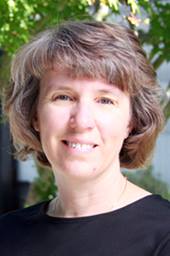Taking Control and Taking Risks
 Image courtesy of Pacific Northwest National Laboratory
Image courtesy of Pacific Northwest National Laboratory
Turning data into codes into images that scientists and engineers can use is a vital part of today's scientific endeavor.
Nearly 20 years ago, Lori Freitag (now Diachin) received a Presidential Early Career Award for Scientists and Engineers (PECASE) for designing ways to visualize and interact with large, complex data sets while working at Argonne National Laboratory (ANL). The award gave her visibility, opportunities, and even led to her current job – her dream job – leading 100 computer scientists who are solving problems vital to national security.
For Lori, a career in science wasn't a foregone conclusion. In high school and college, she found herself drawn to science and art, specifically graphic design. At Edinboro University, a small liberal arts college in Pennsylvania, she decided that science offered the intellectual challenge and financial stability she wanted. After earning her first degree in mathematics, she went to the University of Virginia, where a class in numerical methods set her firmly on her path. "I was really amazed how you could approximate things on the computer."
After graduating, Lori joined ANL in Illinois, working as a computer scientist in computational mathematics, parallel computing, and visualization. As part of this work, she developed a project with a Chicago-area company that built injection systems designed to reduce emissions from boilers and incinerators. She wrote computer algorithms -- series of rules and calculations -- to move the injectors around inside the incinerator in real time and display the results in the virtual reality environment known as the CAVE. In the CAVE, researchers can study and walk around large, detailed images that appear to float in mid-air. Lori demonstrated the results to a host of industrial leaders, scientists, managers, as well as the Secretary of Energy.
Her expertise and the visibility from this project, along with others, led to the PECASE, the highest honor given by the U.S. government to researchers beginning their career. She received this award at the White House in 1997.
 Photo courtesy of Lawrence Livermore National Laboratory
Photo courtesy of Lawrence Livermore National Laboratory
Today, Lori serves as the Director for the Center for Applied Scientific Computing, ensuring scientists have the resources they need to get the job done.
Today, Lori serves as the Director for the Center for Applied Scientific Computing at Lawrence Livermore National Laboratory where she has worked since 2003. She ensures scientists have the resources they need, whether that's cutting-edge tools, extra hands in the lab, or introductions to potential collaborators and clients.
She also mentors early career scientists, helping them get ahead in what can be a tough field. Lori advises them to proactively manage their careers by stretching their skills, taking risks, and removing their blinders about their home organization. "You should know what your organization values. If you get so tied up in what you want to do that you don't see what the organization wants, you won't get opportunities because your values and the organization's don't align."
In addition, she is the point of contact for Lawrence Livermore National Lab's work with the DOE Office of Science's Advanced Scientific Computing Research clients, managing a yearly portfolio of research projects worth around $12 million.
Looking back from the vantage point of a job she loves as well as looking forward to new opportunities, Lori is grateful for the benefits the career award offered her nearly two decades ago. "The award gave me the opportunity to give briefings to higher level managers and talk with three Energy Secretaries early in my career. It made me comfortable giving talks and working with influential people," said Lori. "The early visibility helped catapult my career."
The Office of Science is the single largest supporter of basic energy research in the physical sciences in the United States and is working to address some of the most pressing challenges of our time. For more information please visit http://science.energy.gov.
Kristin Manke is a Communications Specialist at Pacific Northwest National Laboratory on detail to the U.S. Department of Energy's Office of Science, kristin.manke@science.doe.gov.

